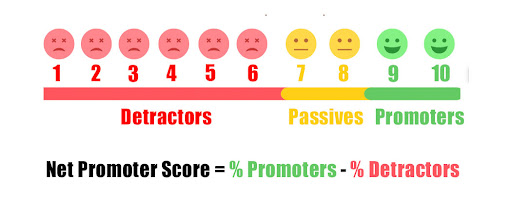Net Promoter Score (NPS)
Net Promoter Score (NPS) Formula
Net Promoter Score (NPS) is a popular survey-based metric to gauge customer loyalty and sentiment. It measures the enthusiasm of customers with the question: "How likely are you to recommend the product/service to a friend or colleague on a scale from 0 to 10?".
Improving Net Promoter Score is a proxy for improving the over customer experience. Businesses with high NPS scores generally also grow much more quickly by retaining their existing customer base and spreading via word of mouth.
Why Is Net Promoter Score (NPS) Important?
Net Promoter Score is an important KPI because it measures overall customer experience correlates with future business growth.
Brand awareness via word of mouth is the gold standard for growth avenues, and NPS is the de facto metric for improving word of mouth.
Net Promoter Score: Definitions
Before we describe how to calculate Net Promoter Score, it's important to define the different categories of customers:
- Detractors: Customers who respond to the survey with a score between 0 to 6. These are customers that are not satisfied with the product or services and may negatively impact the impressions of others.
- Passives: Customers who respond with a score of 7 or 8. The expectation is that these customers are neutral.
- Promoters: Customers who respond to the survey with a score of 9 or 10. These are the customers that are likely to stick around and get other customers to adopt the product.
How Do You Calculate Net Promoter Score?

With the previous definitions in place, we can provide a straightforward formula for calculating Net Promoter Score. Just take the percentage of promoters and subtract the percentage of detractors. Typically the final result is then given as a number between -100 to 100 instead of a percentage.
What is the Industry Standard NPS Score?
According to SurveyMonkey, the median NPS score is 44, while the average is 32. This will of course vary by industry, with B2C businesses having slightly higher NPS than B2B businesses.
What is a Good NPS Score?
According to the research cited above, an NPS of 72 and above counts as a good net promoter score and puts a company in the top quartile of businesses.
Can NPS Score be Manipulated?
While NPS is one of the most frequently used metrics (with a majority of the Fortune 100 using it), it can fluctuate depending on several variables:
- When is the survey sent?
- Through which channel or medium is the survey sent?
- Which group of customers or users is the survey sent to?
Benefits of Measuring and Improving NPS
There are many benefits to measuring and improving NPS:
- It's straightforward, cost-effective, and easy to implement (though there are some gotchas, as described above).
- It can be used to identify changes in customer loyalty and sentiment for the business and paricular products.
- It helps predict the growth of the business.
- It's easy to track NPS over time.
- It helps to benchmark your business against the competition.
How to Improve NPS
First, calculate your net promoter score and do a thorough analysis by product/service and customer segment. Such surveys usually include freeform customer feedback that you should analyze, prioritize, and execute upon.
Here are some specific strategies:
- Always follow up and ask for feedback.
- Reach out to detractors to see if there's some way you can improve their experience.
- Hold regular reviews of the business's NPS metric -- make it part of the primary business dashboard.
- Do a root cause analysis to determine the most common reason for detractors.


